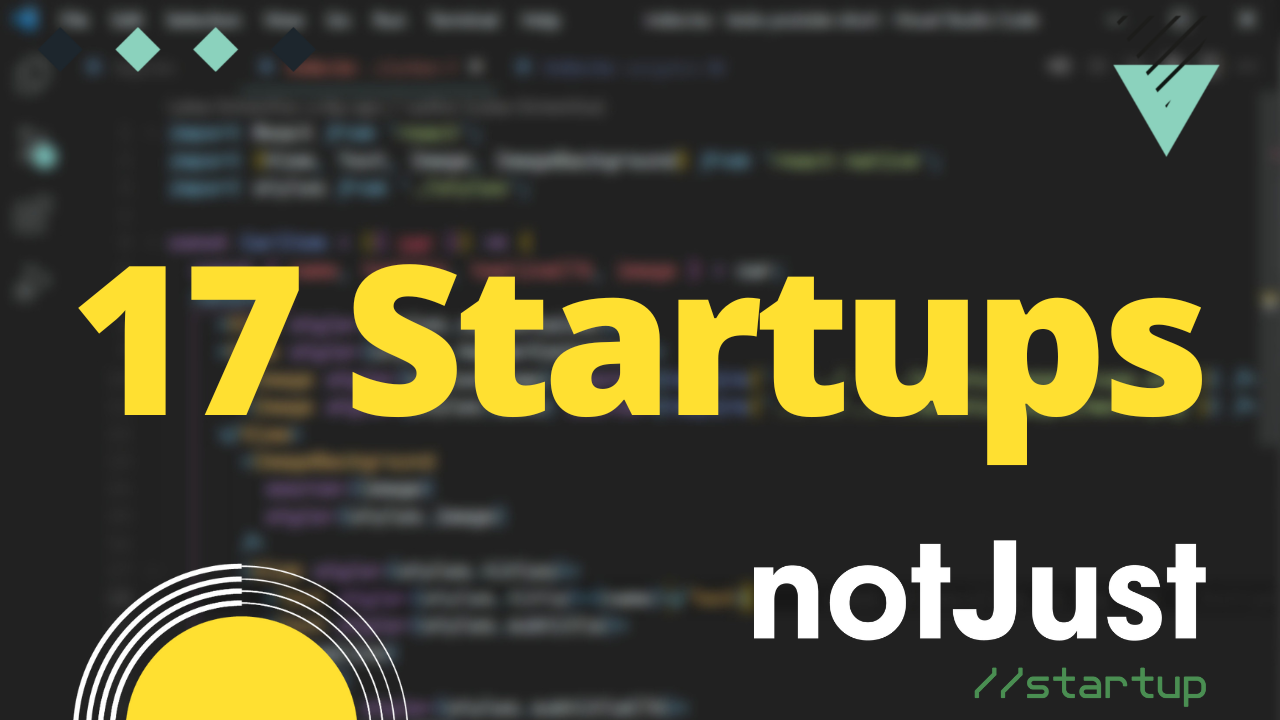Introduction
Let’s build a Virtual Event Application with React Native. Shall we?
You can follow this build in video format here:
If you want to follow along, and build this application yourself, make sure to download the Asset bundle that contains all the dummy data, pre-defined components, PDF presentation and more.
Download the Asset Bundle 👇
To get the Source Code, PDF guide, dummy data, images, etc.
Context
This project is part of the notJust.Hack event, and the goal is to show you that it is possible to build a functional application in just 3 days.
For that reason, I will approach this project in a similar way you would approach a Hackathon project.
The Problem:
Organizing a multi day event such as notJust.Hack, I encounter the problem of sharing the schedule of the event, so that attendees will know what to expect when.
The Solution:
A mobile app that will display information about a Virtual Event, will show a clear schedule and let people RSPV to the sessions that they are interested in.
Attendees will have the possibility to chat and network in the application.
Let’s initialize the App using expo
npx create-expo-app VirtualEvents --template tabs
- Start the development server
npm start
- Run the applicaton by pressing i to run on iOS device/emulator or a to run on android device/simulator.
- You can also scan the QR code using Expo Go App on your physical device
Calendar
For the calendar view, we will use the React Native Calendar library. Check out the docs here
-
Install
BASHnpx expo install react-native-calendars -
Render an Agenda inside the screens/TabOneScreen.tsx
JAVASCRIPTimport { Alert, Pressable, StyleSheet } from "react-native";import { Text, View } from "../components/Themed";import { RootTabScreenProps } from "../types";import {Agenda,AgendaEntry,AgendaSchedule,DateData,} from "react-native-calendars";import { useState } from "react";import events from "../assets/data/events.json";export default function TabOneScreen({navigation,}: RootTabScreenProps<"TabOne">) {const [items, setItems] = useState<AgendaSchedule>({});const loadItems = (day: DateData) => {setItems(events);};const renderEmptyDate = () => {return (<View style={styles.emptyDate}><Text>This is empty date!</Text></View>);};const renderItem = (reservation: AgendaEntry, isFirst: boolean) => {const fontSize = isFirst ? 16 : 14;const color = isFirst ? "black" : "#43515c";return (<Pressablestyle={[styles.item, { height: reservation.height }]}onPress={() => Alert.alert(reservation.name)}><Text style={{ fontSize, color }}>{reservation.name}</Text></Pressable>);};return (<View style={styles.container}><Agendaitems={items}selected={"2022-11-25"}renderItem={renderItem}renderEmptyDate={renderEmptyDate}loadItemsForMonth={loadItems}// showOnlySelectedDayItems/></View>);}const styles = StyleSheet.create({container: {flex: 1,},item: {backgroundColor: "white",flex: 1,borderRadius: 5,padding: 10,marginRight: 10,marginTop: 17,},emptyDate: {height: 15,flex: 1,paddingTop: 30,},});
Event detailed page
Let’s display the details of the event in a Modal. For that, we can use the existing screens/ModalScreen.tsx
- Open the modal when we press on an item in the Agenda List
onPress={() => navigation.navigate("Modal", {id: event.id})}
- Now, let’s Render the deatils of the event
import { AntDesign } from "@expo/vector-icons";import { StatusBar } from "expo-status-bar";import { Platform, StyleSheet, Image } from "react-native";import { Text, View } from "../components/Themed";import { RootStackScreenProps } from "../types";import CustomButton from "../components/CustomButton";import users from "../assets/data/users.json";import event from "../assets/data/event.json";export default function ModalScreen({route,navigation,}: RootStackScreenProps<"Modal">) {const id = route.params.id;console.log("Rendering event ", id);const onJoin = () => {};return (<View style={styles.container}><Text style={styles.title}>{event.name}</Text><Text style={styles.time}><AntDesign name="calendar" size={24} color={"black"} />{" | "}{new Date(event.date).toDateString()}</Text><View style={styles.footer}><Text style={styles.subtitle}>Attendees</Text><View style={styles.users}>{users?.map((user, i) => (<Imagesource={{ uri: user.avatarUrl }}style={[styles.userAvatar,{ transform: [{ translateX: -15 * i }] },]}key={user.id}/>))}<Viewstyle={[styles.userAvatar,{transform: [{ translateX: -15 * users.length }],},]}><Text>+{users.length}</Text></View></View><CustomButton text="Join the event" onPress={onJoin} /></View>{/* Use a light status bar on iOS to account for the black space above the modal */}<StatusBar style={Platform.OS === "ios" ? "light" : "auto"} /></View>);}const styles = StyleSheet.create({container: {flex: 1,padding: 10,paddingBottom: 25,},title: {fontSize: 24,fontWeight: "bold",marginVertical: 10,},subtitle: {fontSize: 18,fontWeight: "bold",},time: {fontSize: 20,},footer: {marginTop: "auto",},users: {flexDirection: "row",marginVertical: 10,},userAvatar: {width: 50,aspectRatio: 1,borderRadius: 30,margin: 2,borderColor: "white",borderWidth: 2,justifyContent: "center",alignItems: "center",backgroundColor: "gainsboro",},});
Render Users
- Create a new component components/UserListItem.tsx
import { View, Text, Image, StyleSheet } from 'react-native';import React from 'react';type UserListItemProps = {user: any,};const UserListItem = ({ user }: UserListItemProps) => {return (<View style={styles.container}><Image source={{ uri: user.avatarUrl }} style={styles.image} /><Text style={styles.name}>{user.displayName}</Text></View>);};const styles = StyleSheet.create({container: {flexDirection: 'row',alignItems: 'center',padding: 5,margin: 5,marginHorizontal: 10,backgroundColor: 'white',borderRadius: 5,},image: {width: 50,aspectRatio: 1,borderRadius: 50,},name: {fontWeight: 'bold',marginLeft: 10,},});export default UserListItem;
- Create a new Screen screens/UsersScreen.tsx
import users from '../assets/data/users.json';import { FlatList } from 'react-native';import UserListItem from '../components/UserListItem';const UsersScreen = () => {return (<FlatListdata={users}renderItem={({ item }) => <UserListItem user={item} />}/>);};export default UsersScreen;
- Add the screen as a Modal in the navigation/index.ts
- Link the header button from the TabOneScreen to open the Users modal
My Account
Let’s use screens/TabTwoScreen as our Profile Page.
import { StyleSheet, Image } from "react-native";import { Text, View } from "../components/Themed";import CustomButton from "../components/CustomButton";import users from "../assets/data/users.json";const user = users[0];export default function TabTwoScreen() {return (<View style={styles.container}><Image source={{ uri: user?.avatarUrl }} style={styles.avatar} /><Text style={styles.name}>{user?.displayName}</Text><View style={{ marginTop: "auto" }}><CustomButtononPress={() => {}}text="Sign out"type="TERTIARY"fgColor="crimson"/></View></View>);}const styles = StyleSheet.create({container: {flex: 1,padding: 10,alignItems: "center",},avatar: {width: 100,aspectRatio: 1,borderRadius: 50,},name: {fontWeight: "bold",fontSize: 22,marginVertical: 15,color: "dimgray",},});
Authentication Screens
For the authentication screens, we will re-use the Auth Screens that we have build in this playlist.
- Install react-hook-form
npx expo install react-hook-form
- From the Asset Bundle, add AuthScreens inside our screens folder
- Add the SignIn and SignOut screens in our RootNavigator
const isAuthenticated = false;if (!isAuthenticated) {return (<Stack.Navigator><Stack.Screenname="SignIn"component={SignInScreen}options={{ title: "Sign in", headerShown: false }}/><Stack.Screenname="SignUp"component={SignUpScreen}options={{ title: "Create an account" }}/></Stack.Navigator>);}return (...)
Next steps
Check out the next part of this project, where we implement the backend of this application using Nhost
✅ Authentications
✅ Database & GraphQL API
✅ Storage
✅ Apollo Client
Watch it live on youtube:



